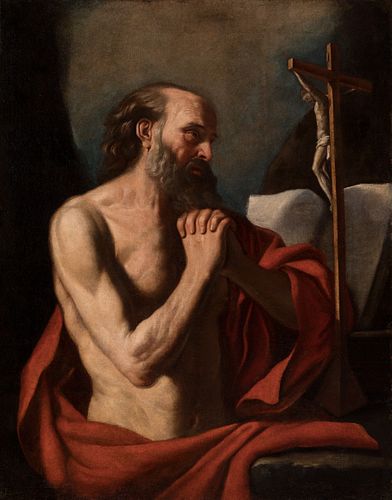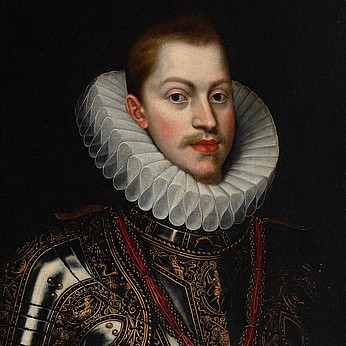Circle of IL GUERCINO (Cento, Italy, 1591-Bologna, 1666); second half of the 18th century. "Penitent St. Jerome." Oil on canvas. Preserves original
Lot 59
About Seller
Setdart Auction House
Carrer Aragó 346
Barcelona
Spain
Setdart Subastas was born in 2004 and is currently the first online art auction in Spain with solidity, prestige and reliability guaranteed by our more than 60,000 users. Setdart has a young, dynamic and enterprising team ready to successfully manage the purchase and sale of art works through custom...Read more
Estimate:
EUR€5,000 - EUR€6,000
$5,376.34 - $6,451.61
Absentee vs Live bid
Two ways to bid:
- Leave a max absentee bid and the platform will bid on your behalf up to your maximum bid during the live auction.
- Bid live during the auction and your bids will be submitted real-time to the auctioneer.
Bid Increments
| Price | Bid Increment |
|---|---|
| EUR€0 | EUR€10 |
| EUR€200 | EUR€25 |
| EUR€500 | EUR€50 |
| EUR€1,000 | EUR€100 |
| EUR€3,000 | EUR€200 |
| EUR€5,000 | EUR€500 |
| EUR€10,000 | EUR€1,000 |
| EUR€20,000 | EUR€2,000 |
| EUR€50,000 | EUR€5,000 |
About Auction
By Setdart Auction House
Nov 24, 2021
Set Reminder
2021-11-24 09:00:00
2021-11-24 09:00:00
America/New_York
Bidsquare
Bidsquare : Old Masters, Day 1
https://www.bidsquare.com/auctions/setdart-auction-house/old-masters-day-1-7873
Setdart Auction House sofia@setdart.com
Setdart Auction House sofia@setdart.com
- Lot Description
Circle of IL GUERCINO (Cento, Italy, 1591-Bologna, 1666); second half of the 18th century. "Penitent St. Jerome." Oil on canvas. Preserves original canvas. Presents repainting and restorations. It has frame of the twentieth century. Measurements: 114 x 91 cm; 119 x 96 cm (frame). In this canvas the theme of penitent Saint Jerónimo is approached, through a classic composition, in which the author arranges the saint in a sober interior, in which any anecdotal detail that could cloud the message of transmission of the Christian faith and devotion is eliminated. One of the four great Doctors of the Latin Church, St. Jerome was born near Aquileia (Italy) in 347. Trained in Rome, he was an accomplished rhetorician and polyglot. Baptized at the age of nineteen, between 375 and 378 he retired to the Syrian desert to lead an anchorite's life. He returned to Rome in 382 and became a collaborator of Pope Damasus. One of the most frequent representations of this saint is his penance in the desert. His attributes are the stone he uses to beat his chest and the skull on which he meditates. Also the cardinal's cape (or a red mantle), although he was never a cardinal, and the tamed lion. The latter comes from a story of the "Golden Legend", where it is narrated that one day, when he was explaining the Bible to the monks of his convent, he saw a lion coming with a limp. He removed the thorn from its paw, and from then on he kept it in his service, instructing it to look after his donkey while it grazed. Some merchants stole the donkey, and the lion recovered it, returning it to the saint without hurting the animal. Due to its technical characteristics, it is possible to relate this piece to the artistic circle of Guercino, who was one of the most acclaimed Italian artists in the first half of the 17th century. He was born in the town of Cento, in the province of Ferrara. The main influences that shaped his style were the Bolognese; Ludovico Carracci, his cousin Anibal Carracci and the Ferrarese Ippolito Scarsella. Apart from a two-year stay in Rome during the papacy of the Bolognese Gregorio XV Ludovisi, he was active in his hometown until 1642 when he moved to neighboring Bologna. He was about twenty-five years old when he came to the attention of his first important clients, among them Cardinal Alessandro Ludovisi, Archbishop of Bologna; Cardinal Jacopo Serra, papal legate in Ferrara; Grand Duke Cosimo II of Tuscany; and Duke Ferdinand Gonzaga of Mantua. By the mid-1620s he had turned down invitations to work outside Italy, from Charles I of England among others. He seems to have been reluctant to enter into direct competition with his Bolognese rivals, especially Guido Reni, who from about 1610 was the most celebrated painter in Italy. Most of his abundant output consists of altar and easel paintings, but in the first half of his career he also painted frescoes in Cento, Bologna, Rome (the Aurora on the ceiling of the Casino Ludovisi) and the cathedral of Piacenza (1626-1627). His early style, "tenebrist", is characterized by dramatic lighting, saturated colors and agitated compositions. His stay in Rome led him to gradually modify his style towards a much more idealized and classical language, with calmer and more structured compositions, more elegant contours, a palette generally lighter and richer in pastel tones.
- Shipping Info
-
In-house shipping available. Please inquire at admin@setdart.com.
-
- Buyer's Premium



 EUR
EUR CAD
CAD AUD
AUD GBP
GBP MXN
MXN HKD
HKD CNY
CNY MYR
MYR SEK
SEK SGD
SGD CHF
CHF THB
THB

















